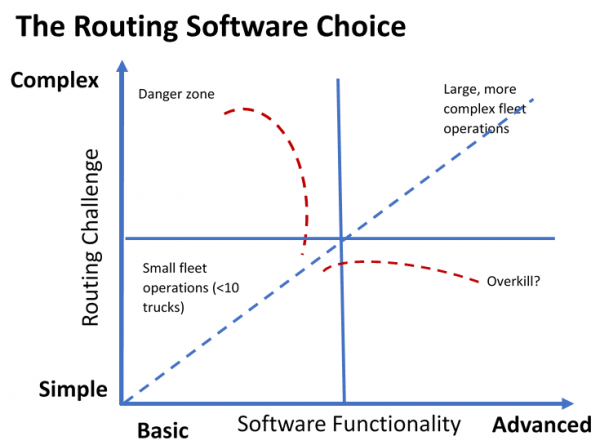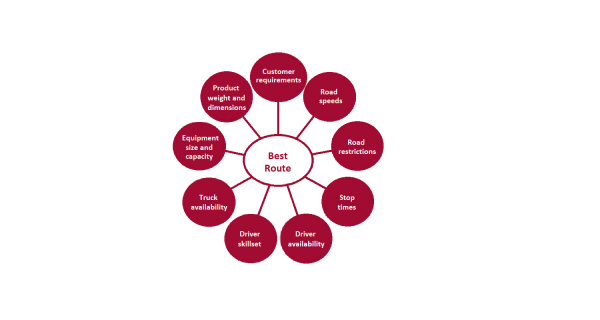It’s good to have choices.
When it comes to routing software, there is certainly no shortage of options – from basic packages offered on a cloud-hosted basis to sophisticated systems designed to cope with every imaginable routing scenario. Figuring out the right solution is challenging, and getting it wrong could mean extra costs and headaches down the road.
One way to overcome this challenge is to evaluate options in the context of a single dimension – SIMPLICITY. Route planning is a very complex process requiring analysis of dozens of variables – preferred delivery time windows, location-specific restrictions, driver skills and availability, truck dimensions and capacity to name just a few. You want a software solution that can overcome this complexity, and that your staff can pick up and use quickly.
But be careful here.
Unless you run a small fleet with basic routing requirements, you want to make sure that your simple, easy-to-use solution is not too simplistic in its functionality.
No one benefits from routing software that’s easy to operate but can’t do what you need it to do. Ideally, you want software that allows route planners to do their jobs with minimal effort, but is sophisticated enough to solve your most complex routing challenges – now and in the future.
The routing software options available to you vary in their functionality. Generally, the larger your fleet, and the more complex your routing challenge, the more advanced functionality you will require.
The diagram below illustrates a general pattern of software choice, along with the common mistakes fleet owners make when choosing routing software.

On the left side, you’ll find basic SaaS solutions that can handle just about all the route planning and scheduling requirements of small (< 10 trucks), less complex operations. But they may not have some critical functionality required by larger fleets with more complex needs. For such companies, this can be a “danger zone” when choosing routing software. The promise of an easy, quick-to-implement routing solution is a powerful lure to busy transportation professionals, but the potential functionality gap can result in profit-draining inefficiencies for the business.
On the right side of the functionality axis are software providers with the more advanced capabilities often required by larger fleets (see “best route” diagram for just a partial list of factors that routing software should consider). Such full-featured software packages, while they offer the benefit of being “future-proof” as your needs grow, might actually exceed the requirements of more basic fleet operations. Too many “bucks” for the “bang” you really require.

For fleets of 10 or less that distribute from a single warehouse, requirements are straightforward, and an out-of-the-box SaaS solution will most likely get the job done at a budget-friendly price.
For large fleets of 500 or more, software choices are limited to robust packages with comprehensive functionality that can handle both core routing requirements and more advanced requirements like dynamic routing and business modeling.
It’s that middle tier of fleet operators – companies with 20 to 200 trucks – for whom choosing routing software is perhaps most difficult. For them, the lure of the simple, easy route planning solution is strong. But, if you commit to a solution that is too simplistic for your needs, your fleet’s operational and financial performance could suffer – undermining the very objectives that prompted you to buy routing software in the first place.
Fleet operators lured by the advantages of basic routing software need to understand the downside of a software solution that does not adequately address their requirements, today and tomorrow.
That downside is literally “the cost of easy.”
How high is that cost? It will depend on your fleet miles, but it will be significant.
Let’s say your fleet drives 2 million miles a year. It would cost you about $3.6 million to keep that fleet and driver force on the road based on ATRI cost-per-mile data of $1.82. Sub-optimized fleet operations overspend by 10 to 30 percent. That’s $350,000 to $1 million in real dollars.
Mid-sized fleet operators with lean staffs want and need a routing software solution that’s easy to use, but it must also have the advanced functionality required to mine these potential savings.
Following are just some examples of functionality that routing software packages may or may not provide, along with the negative business impact of needing these capabilities, but not having them. To truly future-proof your fleet operation, use this list to identify functionality you may now, or one day, require, and compare it to what potential providers can deliver.
| Functionality | Operational Implications |
| Manage distribution from multiple warehouses in a single planning exercise | If you’ve got one DC now and will never expand, this functionality is obviously not required. But if you’ve got two or more DCs, you’ll want to create one route plan that automatically directs customer orders to the warehouse that gets products delivered fastest at the lowest cost. Many basic routing software packages are built using logic that requires a plan for each location. As a result, orders that should be routed dynamically to the best ship-from location would instead require intervention by a planner to over-ride inefficient routes.
The Cost of Easy
Excess miles as customers are served by the wrong DC – ultimately, these excess miles create the need for more trucks and more drivers |
| Run multiple trips daily with a single driver | This sounds easy to do, yet software with more simplistic algorithms can’t handle the advanced logic of running multiple trips in a single driver shift. That could mean the difference between scheduling 8 drivers at 10 hours a day and 10 drivers at 8 hours a day. When might you need a “multi-tripping” capability?
Without this multi-tripping functionality, drivers can decide if they work at a pace that allows the extra trip. Most drivers are salaried and, therefore, not incentivized to increase the number of deliveries per trip. The Cost of Easy
|
| Consider all of the parameters needed to create a precise route plan | The plans of just about all routing software will factor in basic data like road speeds, predictable congestion and turn restrictions. But not all will consider factors like historic stop times at specific customer locations and re-routing requirements linked to low bridges. Still fewer will consider industry-specific parameters like “must be first off the truck” for certain perishables. When the full gamut of factors is not considered, it becomes far more difficult to create accurate plans that consistently hit ETA windows.
The Cost of Easy
Disgruntled drivers frustrated at the imprecise nature of their schedules – when drivers leave, it has become extremely difficult to recruit their replacements |
| Monitor trailer capacity to maximize equipment utilization | All basic routing software will monitor trailer capacity, but the simplest packages consider only a single measure, like cube. More advanced packages consider as many as five user-defined measures – things like cube, weight, boxes, pallets – which can be looked at independently. You want software that’s smart enough to help you deliver the most product using the least amount of equipment. If the software erroneously signals that you’re maxed out on weight when the trailer is half full, you’ll run more vehicles than needed. Software that examines multiple parameters can automatically manage the right mix of cube and weight across the fleet.
The Cost of Easy Inflated fleet size and driver force. Example: One Southwest US produce distributor, after moving from manual route planning to the use of advanced routing software, cancelled the acquisition of 8 of the 10 trucks it had on order, based on predicted efficiencies |
| Plan routes while considering drivers’ hours of service | Most route planning software ignores what is arguably the biggest factor of all in planning routes – driver availability. This knowledge often exists only in the heads of dispatch team members. As a result, otherwise accurate route plans are completely over-hauled in dispatch so they work “in the real world.”
More advanced route planning software includes “resource management” functionality, which considers up-to-date information on drivers’ vacations, shift patterns, skill sets, and actual hours worked – captured through a direct feed from in-cab ELD devices. This allows route planners to automatically produce a fully resourced schedule, reducing last-minute scrambles in dispatch. The Cost of Easy
|
| Adapt software to align with users’ work processes | Most out-of-the-box systems come with a standard interface that can’t really be adapted to suit the preferences of particular users. Let’s say you want to add a column on a report, or even create a new report. The right system makes this fast and easy.
A good analogy might be basic financial management software versus the highly sophisticated dashboards of Fidelity, Schwab and some of the other big investing firms, which allow you to see your investments, future projections and a host of other data in exactly the way you want to view it. Whether it’s money management or route management, when the software tools you use can conform to the way you work and analyze data, the task becomes simpler. The Cost of Easy
More resistance to adopting software-driven processes, and therefore slower ROI on the software investment |
| Obtain advanced software support | All routing software will offer support, but that support will differ greatly between basic SaaS packages and more advanced routing software with dedicated support consultants. It’s almost less of a difference in support capabilities and more a difference in philosophy.
Basic packages will support your software, likely through a general call center, answering questions like “How can I create this report?” or “Why am I stuck on this screen?” Advanced packages will support your business, with a dedicated support consultant who is well-versed in your operations and proactively helps address practical business issues like “How can I know if additional vehicles and drivers are required to support a new customer?” and “Would we reduce delivery costs if we added a warehouse?” The Cost of Easy
|
In the words of Albert Einstein: “Everything should be made as simple as possible, but not simpler.”
So it is with routing software.
For smaller, simpler fleet operations, there is no need to over-engineer the process. Leverage the out-of-the-box functionality of basic routing tools and let the software drive the business. The reward: an easy-to-use, quick-to-adopt, budget-friendly system.
That same software is likely not the best choice for larger fleets with more complex routing challenges. Here you’ll need software with more advanced capabilities that solve for your requirements, now and in the future.
Ironically, the most advanced routing tools can be the simplest to use in the end. Such solutions solve your most complex requirements without the need for custom programming or clunky workarounds. And they are supported by knowledgeable people adept at using the software to achieve desired business results.
Functionality is critically important to efficient truck routing, but in the end that functionality needs to serve the business. When choosing routing software, beware providers whose core value proposition centers around fast, easy implementation. Gravitate instead to providers that want to first do a deep dive on your business objectives, and that understand it’s the business that drives the software, not the other way around.
We’ll send you our latest articles and product updates, along with stories of how we’re helping our customers. You can unsubscribe at any time.
Whether you have questions about our products, our customers or our pricing, contact us and we’ll connect you with one of our experienced team.